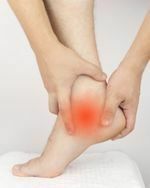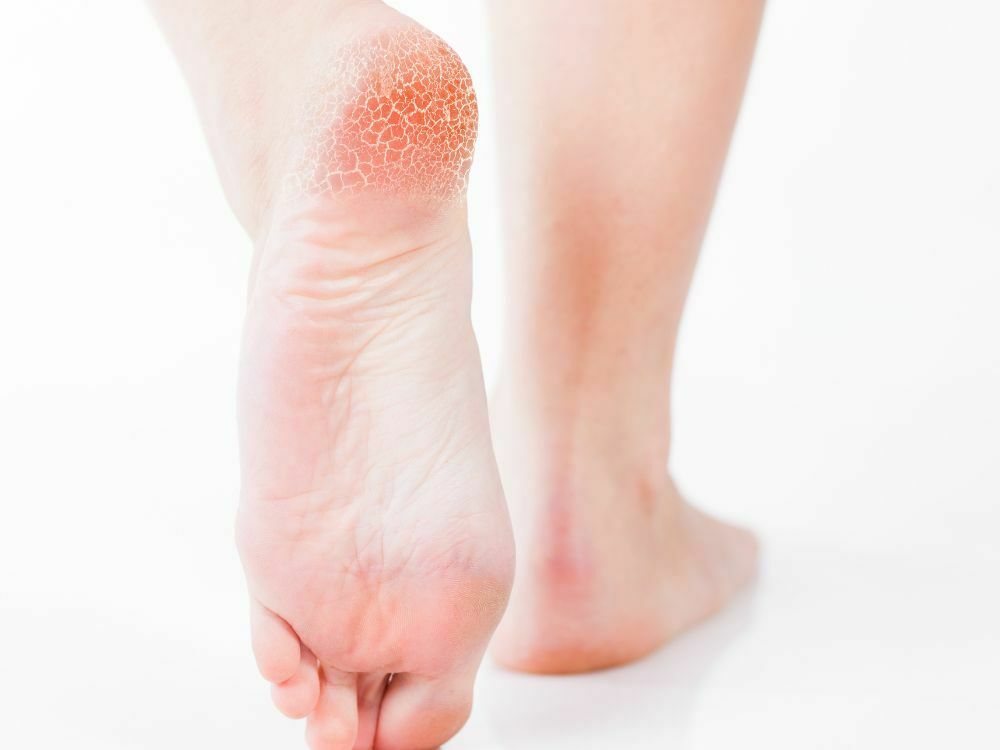Description of heel pain or heel spur

The most common form of heel pain, is pain on the bottom of the heel. It tends to occur for no apparent reason and is often worse when first placing weight on the foot.
Patients often complain of pain the first thing in the morning or after getting up to stand after sitting. The pain can be a sharp, searing pain or present as a tearing feeling in the bottom of the heel. As the condition progresses there may be a throbbing pain after getting off your feet or there may be soreness that radiates up the back of the leg. Pain may also radiate into the arch of the foot.
Heel pain and heel spur cause
To understand the cause of the pain one must understand the anatomy of the foot and some basic mechanics in the function of the foot.

Tout d’abord, examinons les facteurs qui provoquent l’aplatissement et l’étirement excessif du fascia plantaire. Le plus important est la structure de l’assemblage des articulations situé sous la cheville appelé articulation sous-astragalienne. Cette articulation contrôle l’allongement et la remontée de la voûte du pied. La chute de la voûte plantaire est nommée pronation alors que sa remontée, elle est appelée supination. Une chute excessive de la voûte plantaire durant la marche ou la station debout, stresse le fascia plantaire.
Plantar fascia tear
A thick ligament, called the plantar fascia, is attached into the bottom of the heel and fans out into the ball of the foot, attaching into the base of the toes. The plantar fascia is made of dense, fibrous connective tissue that stretches very little. It acts something like a shock absorber.
As the foot impacts the ground with each step, it flattens out, lengthening the foot. This action pulls on the plantar fascia, which stretches slightly. When the heel comes off the ground the tension on the ligament is released. Anything that causes the foot to flatten excessively will cause the plantar fascia to stretch greater than it is accustomed to doing. One consequence of this is the development of small tears where the ligament attaches into the heel bone. When these small tears occur, a very small amount of bleeding occurs and the tension of the plantar fascia on the heel bone may cause a spur on the bottom of the heel to form. Pain experienced in the bottom of the heel is not produced by the presence of the spur. The pain is due to excessive tension of the plantar fascia as it tears from its attachment into the heel bone. Heel spur formation is secondary to the excessive pull of the plantar fascia where it attaches to the heel bone. Many people have heel spurs at the attachment of the plantar fascia without having any symptoms or pain. There are some less common causes of heel pain but they are relatively uncommon.
There are several factors that cause the foot to flatten and excessively stretch the plantar fascia. The primary factor is the structure of a joint complex below the ankle joint, called the subtalar joint. The movement of this joint complex causes the arch of the foot to flatten and to heighten. Flattening of the arch of the foot is termed pronation and heightening of the arch is called supination. If there is excessive pronation of the foot during walking and standing, the plantar fascia is strained. Over time, this will cause a weakening of the ligament where it attaches into the heel bone. When a person is at rest and off their feet, the plantar fascia attempts to mend itself. Then, with the first few steps the fascia re-tears causing pain. Generally after the first few steps, the pain diminishes. This is why the heel pain tends to be worse the first few steps in the morning or after rest.
Diagnosic of heel pain or heel spur
The diagnosis of heel pain and heel spurs is made by a through history of the course of the condition and by physical exam. Weight bearing x-rays are useful in determining if a heel spur is present and to rule out other causes of heel pain such as a stress fracture of the heel bone or the presence of a bone tumor.
Treatment of heel pain and heel spur
Oral anti-inflammatory medications or cortisone injections can be helpful for acute pain. Calf stretching exercises may also be beneficial. If the problem does not resolve or recurs, functional foot orthotics may be considered.’orthèses fonctionnelles, si la condition ne se résorbe pas ou est récurrente.
A functional orthotic is a device that is prescribed and fitted by your foot doctor which fits in normal shoes like an arch support. Unlike an arch support, the orthotic corrects abnormal pronation of the subtalar joint. Thus orthotics address the cause of the heel pain; abnormal pronation of the foot.
Surgery to correct heel pain is generally only recommended if all other treatment has failed. Following surgical treatment to correct heel pain the patient will generally have to continue the use of orthotics. The surgery does not correct the cause of the heel pain. The surgery may eliminate the pain but the process that caused the pain will continue without the use of orthotics. If orthotics have been prescribed prior to surgery they generally do not have to be remade.
Contact your podiatrist
Contact our podiatrist clinic in Laval, we will be delighted to meet you.
The information provided in this web site is not intended to be a substitute for medical examination, diagnosis or treatment. The material is provided for information purposes alone.

